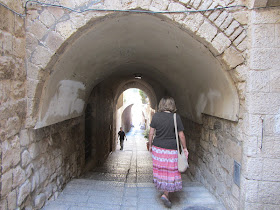 |
| The temple Mount as viewed from the Jewish Quarter |
As a result, I starting this week I am trying to take an afternoon each week to take Elaine to some different sites so that we can examine and see them at a leisurely pace together. Some of them are places I have been before but Elaine has not had a chance to see. Others are on a long list of places that I have always wanted to visit.
Because I gave a midterm and then had a rather long faculty meeting, we did not have quite as much time to go out as I had hoped---we try to get back to the apartment by 3:00 when the children get home from school, because Samuel is not always happy if he comes home and Momma is not here (today, for instance, we did not make it back quite in time, and he left a note: "I came home and you were not here, so I am giving myself a chocolate chip cookie.").
Today's date was to the Jewish Quarter of the Old City. Elaine had not yet been to the Western Wall, what used to be called by some "the wailing wall" because for centuries it had been the site of Jewish mourning for the loss of the temple in A.D. 70. Now the emphasis is less on mourning and simply seeing it as the last remaining contact with ancient holiness, a place where prayers most quickly ascend to the presence of the Lord.
 |
| The men's side |
 |
| The women's side |
The wall is not from the temple proper but rather consists of the the remaining portions of the enormous retaining wall that Herod the Great built to hold up the temple platform. Only the lower courses of stones, massive Herodian ashlars, are actually from the Second Temple, although some 21 courses lie below the level of today's street. Above the big stones of Herod are many rows of later Byzantine stones, topped by courses of even smaller, more irregular Arab and Turkish stones.
After splitting up, Elaine to the women' side and me to the men's, to go up to the wall and experience the kind of worship that takes place there, we left the plaza and climbed the steps into today's Jewish Quarter proper. In the first century, it lay across the deep Tyropoean Valley in what was then the Upper City. When the Romans took Jerusalem in A.D. 70, this was the last part of the city to hold out. One of the small museums we visited was "The Burnt House," the remains of the home of a well-to-do priestly family that was destroyed when the Upper City fell.
 |
| Restored Jewish Quarter on the hill opposite the Western Wall Plaza |
In the Turkish city and then under the British Mandate this was the part of the Old City where many Jews of different backgrounds lived, but during the 1948 War of Independence, the Israelis lost control of it to the Arab Legion of the Kingdom of Jordan. The Jewish inhabitants were expelled, all but one of the Jewish synagogues were destroyed, and the quarter was left in ruins. When the Israelis retook the Old City in the 1967 war, the quarter was restored, but first serious archaeological work was done throughout. The restored areas feel considerable different than the rest of the Old City, mostly because they are not old but also because considerable money has been invested.
One of the great synagogues that was destroyed, the Hurva, has been rebuilt. Tours of it are done only by appointment, so we will need to see the inside at a later date, but it is impressive from the outside. It has added a white "Jewish dome" to the Old City's vista, which has the gold Dome of the Rock, the dark gray dome of the Al Aqsa Mosque, and the slate blue domes of the Church of the Holy Sepulchre.
 |
| The Hurva today |
 |
| The only Muslim minaret left in the Jewish Quarter interestingly is right next to the Hurva |
One of the archaeological sites off of the Cardo has revealed city walls from the First Temple Period (the ninth century B.C. or earlier) and the Hasmonean period (second century B.C.). This might not be particularly interesting to many of you, but the following clip will reveal that this is just my type of thing!
For good measure, here are the footings of the defensive wall built in the eight century about the time of Hezekiah. This was when Jerusalem first expanded from the eastern hill across the valley to the western hill in order to accommodate refugees from the northern kingdom of Israel, which had just fallen to the Assyrians. This is possibly when people from Manasseh and Ephraim, such as the families of Lehi, Laban, Sariah, and Ishmael may have moved to Jerusalem
 |
| The Broad Wall contains the remains of the wall built by Hezekiah |
Elaine and I got lunch and then prowled around the Jewish Quarter a bit more, finally stumbling upon some Crusader ruins before hurrying back to the Center to see the kids.
 |
| The green bags contain sukkot or booths that are used during the coming Festival of Tabernacles. |
 |
| Elaine was really interested in these Crusader ruins |














No comments:
Post a Comment